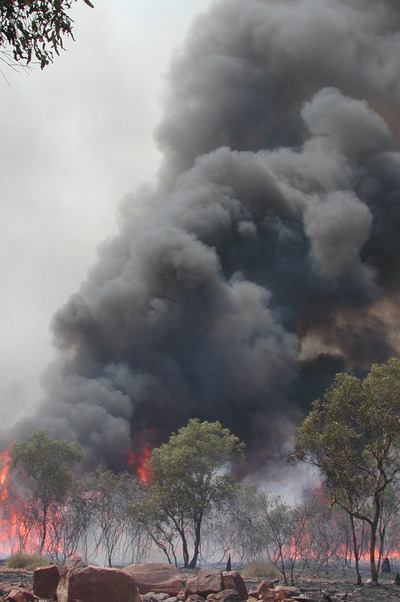Study reveals the seasonal influence of aerosols on Australia’s tropical climate
The first long-term study of fine smoke particles generated by burning of the savannah - open woodland and grassland - has been completed. This means the seasonal influence of aerosols on Australia’s tropical climate can now be included in climate models.
Australia’s biomass burning emissions comprise 8% of the global total, ranking third by continent behind Africa (48%) and South America (27%). Burning is particularly widespread during the May to October dry season, with approximately 30% by area of the savannah regions lying within Western Australia and the Northern Territory being burnt each season. Similar seasonal burning also takes place in the savannah regions of Queensland. The majority is carried out deliberately in order to reduce woody undergrowth and promote subsequent grass growth for grazing, although fires also occur naturally through lightning strikes.

The study’s lead researcher, Dr Ross Mitchell of CSIRO, explained that fine particles generated by burning of the tropical savannah of Northern Australia are a globally significant aerosol source, with impacts on regional climate and air quality.
“Aerosols play a very important role in modulating climate, yet the knowledge of perhaps the most basic piece of information - the seasonal climatology - remains undetermined for many aerosol-producing regions,” said Dr Mitchell.
“Our latest research defines the aerosol climatology of the Australian savannah by combining observations from CSIRO and the Bureau of Meteorology monitoring stations across northern Australia, spanning 12-14 years.”
Measurements were carried out at three widely separated stations across northern Australia; according to Dr Mitchell, variation was expected “due to differences in the timing and intensity of fires, combined with separations of up to 800 km”.
The new monthly climatology shows the expected rise in emissions during the late dry season coming to a peak in October, with clear evidence of dominant fine-particle smoke emission.
“You expect to see a relationship between the measurements if you average them over time, say a month, as the day-to-day variations are smoothed out and the ‘seasonal’ factors of fuel flammability and meteorology take over. The measurements indeed confirm this,” said Dr Mitchell.
“Surprisingly, the relationship remains high even for periods as short as five days. This tells us something unexpected about the combustion and transport of the smoke that needs to be captured by fire models. It also tells us that having just one seasonal cycle for the entire Australian savannah might be enough - simplifying the task of properly representing this aerosol in climate models.”
The research was supported by the Australian Government’s Climate Change Science Program, the US Department of Energy and Bureau of Meteorology observers. It connects with the carbon cycle work of Dr Vanessa Haverd and her team, who recently showed that lack of adequate fire modelling in the Australian savannah contributes very large uncertainty to the regional and national carbon budget.
The paper was published in Geophysical Research Letters. Dr Mitchell anticipates that its results will be used to guide development of a fire model for this region.
Japanese investment accelerates Aussie cleantech
Mitsubishi Ube Cement Corporation has announced a US$5 million investment into Australian mineral...
Yarra Valley Water nominated for global water award
Yarra Valley Water has been named as one of four finalists shortlisted for the Public Water...
Officeworks launches all-women-led commercial solar project
The commercial solar initiative is in partnership with Smart Commercial Solar and AWISE and...








